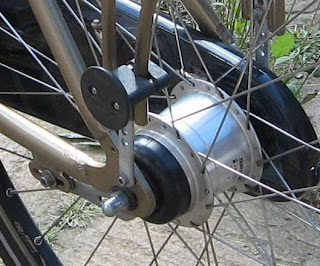I like hubgeared bikes; in fact I don’t
think I’ll ever buy a bike for my own use that isn’t. A hubgear is
one where all the cogs are enclosed within a cylinder that forms the hub of the
backwheel. They have been around a long time – since 1896 or so, and were very popular up
until pushbikes were started to be seen as only for leisure or as toys, when
everything went derailleur (where all the cogs are on the outside) – in the
1970s. Probably the best known and most familiar to many of you is the Sturmey
Archer 3 speed (this one I bought for a tenner on ebay to practice taking apart and putting back together):
Others include: the Sturmey Archer 5 speed - currently on my bike:
And the SRAM i-motion 9, 9 speed - the one which broke (and would cost about £400 to replace):
Main advantages include:
1) Greatly reduced maintenance due to the
cylinder/drum (whatever you wish to call it) enclosing the working parts.
2) You can change gear when stationery, so therefore
they are better for town biking where you may need to stop at a traffic lights
and therefore need to change down to a lower gear to start up again when the
lights change.
Disadvantages include their weight (relatively heavy), tend to have a lower ranges (the exception is the Rohloff)
(so may be at a disadvantage on hilly areas; this is why not many road bikes
(racers) and other sport bikes have them). Those with more than 3 gears are also complex, making them
difficult and expensive to fix (as I found out), especially in this country,
where they are comparatively rare and nobody knows how to repair them. However, this seems to be changing as more
models become available from the major manufacturers, Shimano, SRAM and Sturmey
Archer; and slow cycling through towns becomes more popular.
I prefer hub gears not just for the advantages
in maintenance and urban biking, but also because I just like the look of them:
there’s something neat about that little drum with all the working parts inside
it tucked away. For me, they evoke images of a leisurely urban cycling
lifestyle of the past and of Europe – especially Holland and Denmark. This is
still quite rare in the UK (outside of London) where it is mostly
head-to-the-handlebars seriousness, cycling shorts and shades. They’re almost
an obsession: whenever I see pushbikes, I look straight to the rear wheel to
see if it has a hubgear!
Hub gear manufacturers:
Further info:




